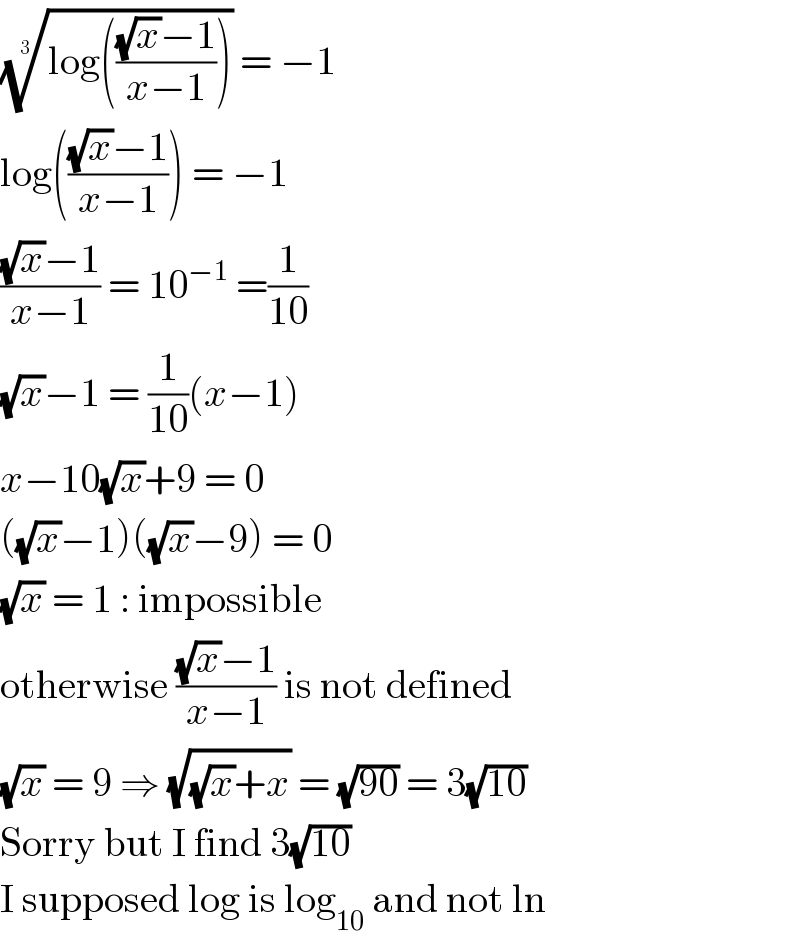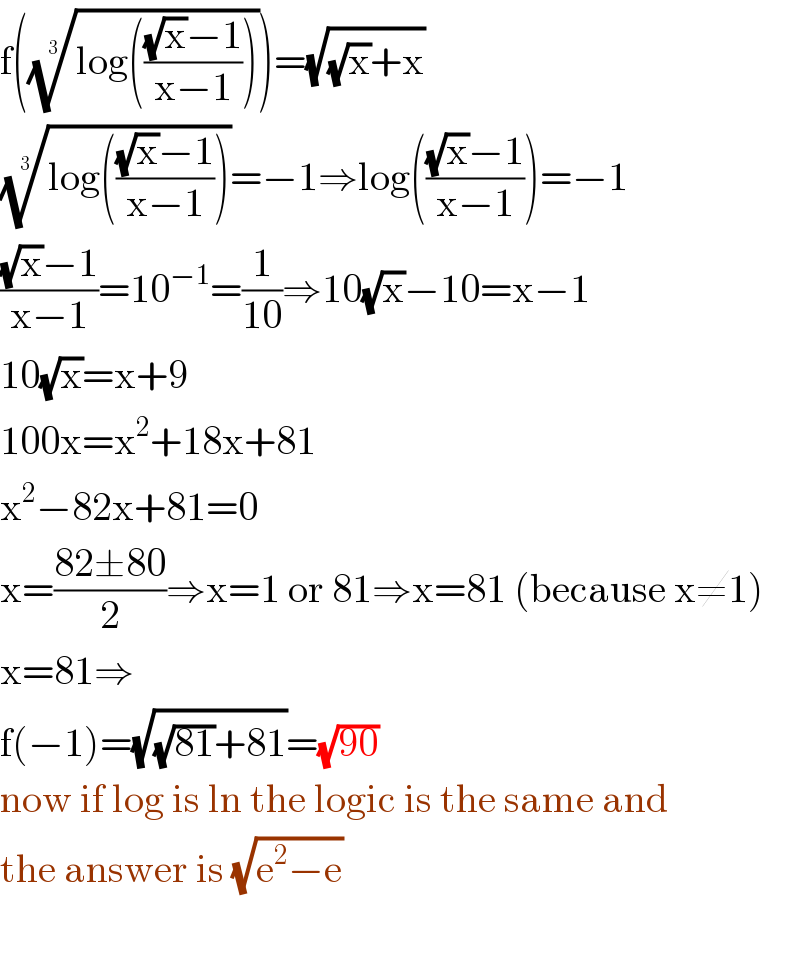Question Number 114597 by O Predador last updated on 19/Sep/20
![What is the number value of f[((log((( (√(x )) − 1 )/(x − 1))) ))^(1/3) ] = (√((√(x )) + x )) for f(−1)? a) 0,1 b) 27 c) 81 d) 10 e) 12](https://www.tinkutara.com/question/Q114597.png)
$$\: \\ $$$$\:\:\:\boldsymbol{\mathrm{What}}\:\:\boldsymbol{\mathrm{is}}\:\:\boldsymbol{\mathrm{the}}\:\:\boldsymbol{\mathrm{number}}\:\:\boldsymbol{\mathrm{value}}\:\:\boldsymbol{\mathrm{of}}\:\:\:\boldsymbol{\mathrm{f}}\left[\sqrt[{\mathrm{3}}]{\boldsymbol{\mathrm{log}}\left(\frac{\:\sqrt{\boldsymbol{\mathrm{x}}\:\:}\:−\:\:\:\mathrm{1}\:}{\boldsymbol{\mathrm{x}}\:\:\:−\:\:\:\mathrm{1}}\right)\:\:}\right]\:\:=\:\:\sqrt{\sqrt{\boldsymbol{\mathrm{x}}\:}\:\:\:+\:\:\:\boldsymbol{\mathrm{x}}\:}\:\:\boldsymbol{\mathrm{for}}\:\:\boldsymbol{\mathrm{f}}\left(−\mathrm{1}\right)? \\ $$$$\: \\ $$$$\left.\:\:\:\boldsymbol{\mathrm{a}}\right)\:\mathrm{0},\mathrm{1} \\ $$$$\left.\:\:\:\boldsymbol{\mathrm{b}}\right)\:\mathrm{27} \\ $$$$\left.\:\:\:\boldsymbol{\mathrm{c}}\right)\:\mathrm{81} \\ $$$$\left.\:\:\:\boldsymbol{\mathrm{d}}\right)\:\mathrm{10} \\ $$$$\left.\:\:\:\boldsymbol{\mathrm{e}}\right)\:\mathrm{12} \\ $$$$\: \\ $$
Answered by Olaf last updated on 19/Sep/20

$$\sqrt[{\mathrm{3}}]{\mathrm{log}\left(\frac{\sqrt{{x}}−\mathrm{1}}{{x}−\mathrm{1}}\right)}\:=\:−\mathrm{1} \\ $$$$\mathrm{log}\left(\frac{\sqrt{{x}}−\mathrm{1}}{{x}−\mathrm{1}}\right)\:=\:−\mathrm{1} \\ $$$$\frac{\sqrt{{x}}−\mathrm{1}}{{x}−\mathrm{1}}\:=\:\mathrm{10}^{−\mathrm{1}} \:=\frac{\mathrm{1}}{\mathrm{10}} \\ $$$$\sqrt{{x}}−\mathrm{1}\:=\:\frac{\mathrm{1}}{\mathrm{10}}\left({x}−\mathrm{1}\right) \\ $$$${x}−\mathrm{10}\sqrt{{x}}+\mathrm{9}\:=\:\mathrm{0} \\ $$$$\left(\sqrt{{x}}−\mathrm{1}\right)\left(\sqrt{{x}}−\mathrm{9}\right)\:=\:\mathrm{0} \\ $$$$\sqrt{{x}}\:=\:\mathrm{1}\::\:\mathrm{impossible} \\ $$$$\mathrm{otherwise}\:\frac{\sqrt{{x}}−\mathrm{1}}{{x}−\mathrm{1}}\:\mathrm{is}\:\mathrm{not}\:\mathrm{defined} \\ $$$$\sqrt{{x}}\:=\:\mathrm{9}\:\Rightarrow\:\sqrt{\sqrt{{x}}+{x}}\:=\:\sqrt{\mathrm{90}}\:=\:\mathrm{3}\sqrt{\mathrm{10}} \\ $$$$\mathrm{Sorry}\:\mathrm{but}\:\mathrm{I}\:\mathrm{find}\:\mathrm{3}\sqrt{\mathrm{10}} \\ $$$$\mathrm{I}\:\mathrm{supposed}\:\mathrm{log}\:\mathrm{is}\:\mathrm{log}_{\mathrm{10}} \:\mathrm{and}\:\mathrm{not}\:\mathrm{ln} \\ $$
Commented by O Predador last updated on 20/Sep/20

$$\:\mathrm{Thank}\:\mathrm{you}! \\ $$
Answered by floor(10²Eta[1]) last updated on 20/Sep/20

$$\mathrm{f}\left(\sqrt[{\mathrm{3}}]{\mathrm{log}\left(\frac{\sqrt{\mathrm{x}}−\mathrm{1}}{\mathrm{x}−\mathrm{1}}\right)}\right)=\sqrt{\sqrt{\mathrm{x}}+\mathrm{x}} \\ $$$$\sqrt[{\mathrm{3}}]{\mathrm{log}\left(\frac{\sqrt{\mathrm{x}}−\mathrm{1}}{\mathrm{x}−\mathrm{1}}\right)}=−\mathrm{1}\Rightarrow\mathrm{log}\left(\frac{\sqrt{\mathrm{x}}−\mathrm{1}}{\mathrm{x}−\mathrm{1}}\right)=−\mathrm{1} \\ $$$$\frac{\sqrt{\mathrm{x}}−\mathrm{1}}{\mathrm{x}−\mathrm{1}}=\mathrm{10}^{−\mathrm{1}} =\frac{\mathrm{1}}{\mathrm{10}}\Rightarrow\mathrm{10}\sqrt{\mathrm{x}}−\mathrm{10}=\mathrm{x}−\mathrm{1} \\ $$$$\mathrm{10}\sqrt{\mathrm{x}}=\mathrm{x}+\mathrm{9} \\ $$$$\mathrm{100x}=\mathrm{x}^{\mathrm{2}} +\mathrm{18x}+\mathrm{81} \\ $$$$\mathrm{x}^{\mathrm{2}} −\mathrm{82x}+\mathrm{81}=\mathrm{0} \\ $$$$\mathrm{x}=\frac{\mathrm{82}\pm\mathrm{80}}{\mathrm{2}}\Rightarrow\mathrm{x}=\mathrm{1}\:\mathrm{or}\:\mathrm{81}\Rightarrow\mathrm{x}=\mathrm{81}\:\left(\mathrm{because}\:\mathrm{x}\neq\mathrm{1}\right) \\ $$$$\mathrm{x}=\mathrm{81}\Rightarrow \\ $$$$\mathrm{f}\left(−\mathrm{1}\right)=\sqrt{\sqrt{\mathrm{81}}+\mathrm{81}}=\sqrt{\mathrm{90}} \\ $$$$\mathrm{now}\:\mathrm{if}\:\mathrm{log}\:\mathrm{is}\:\mathrm{ln}\:\mathrm{the}\:\mathrm{logic}\:\mathrm{is}\:\mathrm{the}\:\mathrm{same}\:\mathrm{and} \\ $$$$\mathrm{the}\:\mathrm{answer}\:\mathrm{is}\:\sqrt{\mathrm{e}^{\mathrm{2}} −\mathrm{e}} \\ $$$$ \\ $$
Answered by 1549442205PVT last updated on 20/Sep/20

$$\mathrm{We}\:\mathrm{need}\:\mathrm{find}\:\mathrm{x}>\mathrm{0},\:\mathrm{x}\:\neq\mathrm{1such}\:\mathrm{that}\: \\ $$$$\mathrm{log}\frac{\sqrt{\mathrm{x}}−\mathrm{1}}{\mathrm{x}−\mathrm{1}}=−\mathrm{1}\Leftrightarrow\mathrm{log}\frac{\sqrt{\mathrm{x}}−\mathrm{1}}{\left(\sqrt{\mathrm{x}}−\mathrm{1}\right)\left(\sqrt{\mathrm{x}}+\mathrm{1}\right)}=−\mathrm{1} \\ $$$$\Leftrightarrow\mathrm{log}\frac{\mathrm{1}}{\:\sqrt{\mathrm{x}}+\mathrm{1}}=−\mathrm{1}\Leftrightarrow−\mathrm{log}\left(\sqrt{\mathrm{x}}+\mathrm{1}\right)=−\mathrm{1} \\ $$$$\bullet\mathrm{If}\:\mathrm{logx}=\mathrm{log}_{\mathrm{10}} \mathrm{x}\:\mathrm{then} \\ $$$$\Leftrightarrow\mathrm{log}\left(\sqrt{\mathrm{x}}+\mathrm{1}\right)=\mathrm{1}\Rightarrow\sqrt{\mathrm{x}}+\mathrm{1}=\mathrm{10} \\ $$$$\Leftrightarrow\sqrt{\mathrm{x}}=\mathrm{9}\Leftrightarrow\mathrm{x}=\mathrm{81} \\ $$$$\Rightarrow\mathrm{f}\left(−\mathrm{1}\right)=\sqrt{\mathrm{9}+\mathrm{81}}=\sqrt{\mathrm{90}} \\ $$$$\bullet\mathrm{If}\:\mathrm{logx}\:=\:\mathrm{lnx}\:\mathrm{then}\:\sqrt{\mathrm{x}}+\mathrm{1}=\mathrm{e}\Rightarrow\sqrt{\mathrm{x}}=\mathrm{e}−\mathrm{1} \\ $$$$\Rightarrow\mathrm{x}=\mathrm{e}^{\mathrm{2}} −\mathrm{2e}+\mathrm{1}\Rightarrow\mathrm{f}\left(−\mathrm{1}\right)=\sqrt{\:\mathrm{e}^{\mathrm{2}} −\mathrm{e}} \\ $$$$\boldsymbol{\mathrm{Available}}\:\boldsymbol{\mathrm{answer}}\:\boldsymbol{\mathrm{is}}\:\boldsymbol{\mathrm{false}}! \\ $$
